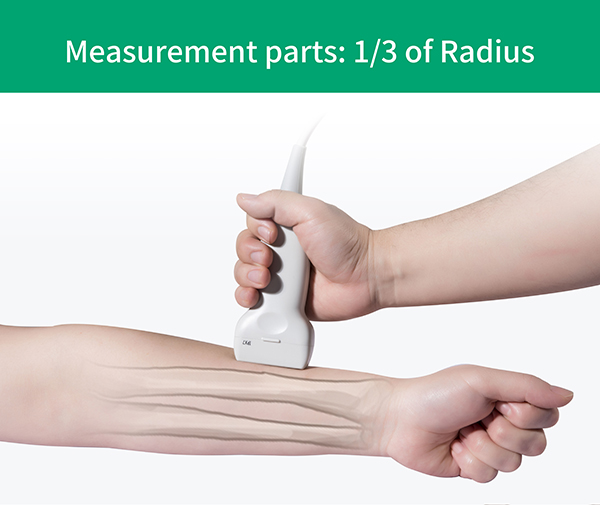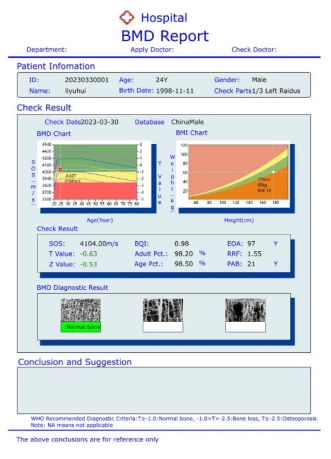In simple terms, a bone mineral density test is designed to find out if we have osteoporosis, which is how many people understand it, but it also allows you to see if you are losing bone mass. Do you know what bone mineral density tests are? What about the bone density report? Let's find out!
Five ways to measure bone density
1. Double energy X-ray absorptiometry (referred to as DXA or DEXA) is the best detection method, and has been widely used, this test is painless and rapid, but also can detect bone density. Another big benefit of this method is that it emits very little radiation to people - so little that the doctor can stay next to the scanning machine and not have to leave the room during the test.
2. ultrasonic testing is now very common. It's fast, inexpensive, and radiation-free. Ultrasounds can measure bone density in the tibia and radius, and they can give an idea of the health of bones throughout the body.
3. Mono-energy X-ray absorptiometry can measure bone density in the heel and wrist, but not in the hip and vertebrae, which are often more important. However, its cost is relatively low compared to DXA, and the bone density of the heel and wrist can also be a good indication of the health of the whole body bone.
4. Quantitative computed tomography (CT) can measure the density of the hip bones and vertebrae, but it is more expensive than DXA and the subject is exposed to more radiation.
5. X-rays can detect fractures, but they can't measure bone density as accurately as other methods.
How to read bone mineral density test
I believe that people who have had bone density tests should have an impression of the "T value" and "Z value". In general, the BMD test results are often given feedback in the form of "picture + table" : The "picture" intuitively shows the bone mineral density of the subject in the specific position of the Chinese male (female) bone mineral density reference curve; The table lists the values of the T and Z values directly.
1. Understand the "T" value
The "T-value" is divided into three intervals, each representing a different meaning.
-1<T value <1 indicates normal bone mineral density.
-2.5<T value <-1 indicates low bone mass and bone loss.
A T value <-2.5 indicates osteoporosis.
T value is a relative value, usually use T to determine the value of clinical bone mineral density is normal, it will detect the detection by bone mineral density and 30 ~ 35 healthy bone mineral density compared to the young, to reach higher (+) or lower (-) standard difference among young people.
2. Understand the "Z" value
The "z-value" is divided into two intervals, each of which also represents different meanings.
A value of -2<Z indicates a bone mineral density value within the normal age range.
A Z-value ≤-2 indicates lower bone mineral density than normal peers.
Z value is a relative value, according to the same age, and sex and ethnic groups, the corresponding detection of bone mineral density values compare to reference. When a Z-value below the reference value occurs, it should be brought to the attention of the patient and clinician. A normal Z-value does not indicate that there is no problem at all, for example, a normal Z-value does not mean that an elderly person is less likely to have an osteoporotic fracture. Because with the loss of bone mass in the same age group, the bone density of the elderly is decreasing, and the brittleness of the bones is further increased. At this time, it is more necessary to refer to the T value to accurately judge the bone density.
Bone mineral density examination is mainly used in three aspects
Bone densitometry is widely used in clinic.
(1) Early diagnosis of osteoporosis and prediction of fracture risk.
(2) on the endocrine and metabolic bone disease of bone mass measurement, thus to develop safety, best treatment, prevent the fracture.
(3) Follow-up and curative effect evaluation.
The method is simple and requires no special preparation
Many people think that the inspection of bone mineral density is very complicated, there is no time to check, in fact, with the development of technology, most bone mineral density meters now have the advantages of highly accurate, simple operation, no damage and so on. There is no need for special preparation before the examination, and there is no pain during the determination, similar to CT and X-ray examination. The results were statistically processed by computer. Generally speaking, bone mineral density examination is carried out one part at a time, and the examination results also reflect the bone mineral density value of a certain part, and the whole body condition needs to be comprehensively evaluated.
Which groups of people need bone density examination
1. People with fragility fractures or a family history of fragility fractures should be tested with a high-precision BMD measurement.
2.long-term smoking and drinking, often drink coffee, lack of exercise, menopausal women and other groups.
3.X-ray testing can also find the politics of osteoporosis, once found, you should also do a detailed bone density examination.
4.if the patient is doing osteoporosis treatment, bone density examination can play a role in monitoring the treatment effect.
5.three months of pregnancy and six months each check bone density, can be a good monitor whether pregnant women calcium deficiency.
6. Women over the age of 60 and men over the age of 65 should have a bone density test every year.
7. People with chronic diseases need to have their bone density checked regularly.
Good daily habits help prevent bone disease
If you want to prevent bone diseases and make your bones more healthy, then we should pay attention to controlling the diet structure, have reasonable eating habits, avoid excessive intake of acidic foods, and strengthen acidic constitution. The daily intake ratio of acidic food to alkaline food for healthy people should be 1:4.
It is very necessary to give up smoking and drinking. Everyone knows that smoking is harmful to health. Smoking can affect the formation of bone peaks, and excessive alcohol consumption is not conducive to bone metabolism. Drinking strong coffee can increase urinary calcium excretion, affect the body's absorption of calcium, intake of too much salt and protein will also increase calcium loss.
Exercise speeds up your metabolism. Proper exercise and adequate sunlight are conducive to calcium absorption. In the daily diet, we should often eat calcium-rich foods and develop good living habits.
Conclusion: After reading the above introduction, I hope you can understand the knowledge of bone density examination, you should also do regular physical examination to understand your physical condition. We should take a daily calcium supplement, so that more calcium can be deposited in the bones, so that the peak bone density will rise higher, and the risk of osteoporosis in old age can be reduced.
Post time: Sep-20-2024


